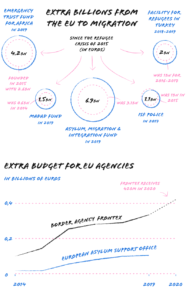Drei Journalist*innen gehen der einfachen Frage nach, wie viel Geld Europa in Nigeria investiert, um die Migration aufzuhalten. Ein klare Antwort darauf erweist sich als unmöglich. Die europäischen Finanzströme für die Migration sind so verwirrend wie ein Teller Spaghetti, schreiben sie. Das ist problematisch, aber auch typisch für die europäische Migrationspolitik in Afrika.
Europe spends billions stopping migration. Good luck figuring out where the money actually goes
Maite Vermeulen, Ajibola Amzat and Giacomo Zandonini
In a shiny new factory in the Benin forest, a woman named Blessing slices pineapples into rings. Hundreds of miles away, at a remote border post in the Sahara, Abubakar scans travellers’ fingerprints. And in village squares across Nigeria, Usman performs his theatre show about the dangers of travelling to Europe.
What do all these people have in common?
All their lives are touched by the billions of euros European governments spend in an effort to curb migration from Africa.
Since the summer of 2015, when countless boats full of migrants began arriving on the shores of Greece and Italy, Europe has increased migration spending by billions.
And much of this money is being spent in Africa.[1]The EU finances migration projects in at least 26 African countries, particularly in west, east and north Africa.
Within Europe, the political left and right have very different ways of framing the potential benefits of that funding. Those on the left say migration spending not only provides Africans with better opportunities in their home countries but also reduces migrant deaths in the Mediterranean. Those on the right say migration spending discourages Africans from making the perilous journey to Europe.
However they spin it, the end result is the same: both left and right have embraced funding designed to reduce migration from Africa. In fact, the European Union (EU) plans to double migration spending under the new 2021-2027 budget, while quadrupling spending on border control.
The three of us – journalists from Nigeria, Italy and the Netherlands – began asking ourselves: just how much money are we talking here?
At first glance, it seems like a perfectly straightforward question. Just add up the migration budgets of the EU and the individual member states and you’ve got your answer, right? But after months of research, it turns out that things are nowhere near that simple.
In fact, we discovered that European migration spending resembles nothing so much as a gigantic plate of spaghetti.[2]For the record, as an Italian, Giacomo is not a huge fan of this particular metaphor.
If you try to tease out a single strand, at least three more will cling to it. Try to find where one strand begins, and you’ll find yourself tangled up in dozens of others.
This is deeply concerning. Though Europe maintains a pretence of transparency, in practice it’s virtually impossible to hold the EU and its member states accountable for their migration expenditures, let alone assess how effective they are. If a team of journalists who have devoted months to the issue can’t manage it, then how could EU parliament members juggling multiple portfolios ever hope to?
This lack of oversight is particularly problematic in the case of migration, an issue that ranks high on European political agendas. The subject of migration fuels a great deal of political grandstanding, populist opportunism, and social unrest. And the debate surrounding the issue is rife with misinformation. […]
[Diese Recherche ist ursprünglich unter dem Titel Niemand weet, niemand weet… hoe Europa zijn migratiemiljarden besteedt in niederländischer Sprache auf dem Portal De Correspondent erschienen.]

